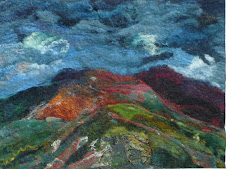Posted by Helen

Stormy sky and hills 1


Srormy sky and hills 2
This is both about growing colour quite literally as plants in my garden and also about using them. I dye fibres with natural dyes and use them to "paint" with. This is how I make my landscapes , mostly of the North Wales countryside Mae Tyfu Lliw yn enw addas iawn i'r 'blog' yma. Yr wyf yn cael hwyl yn tyfu bob math o flodau i Helen i'w defnyddio. Mae hi yn creu lluniau bendigedig, mae y lliwiau yn hollol naturiol, ac felly'n gweithio'n dda iawn yn rhoi lliw credadwy o'r wlad o'm cwmpas







 Posted by Helen
Posted by Helen





I expected to find that this amount of fresh Isatis Indigotica would have dyed 100 g of wool much deeper blue. Leena had the most fantastic result with her persicaria (polygonum) Tinctoria the Japanese Dyer knotweed and I was hoping for something similar!
The dogs and I went off for a walk to think about this. Provided the dogs are well behaved this I find is a good thinking time. Then I had a light bulb moment when I remembered that Enys and her DH only manure and dig over the bits where the vegetable are grown and don't feed the areas where the dye plants and the the herbs grow. I know they have not been watered with a nitrogen feed which mine have and I felt that one of the reason for the weak vat was the fact that the plants had not been fed., woad ( isatis Tinctoria)was/is notorious for needing rich well manured soil and I assume the chinese variety would be the same. I also think that the pH was too high for wool. I find that wood dyes best at pH 8.5-9 and at a hand hot temperature.
Here is another experiment . Remember? Back in the days , at the beginning of July ,when we thought we might have a sunny summer I put this out in my sunny spot. 
The tannin bearing plants which with iron quite quickly went black. The fibres on the top of the jar went black ( well until I washed them but the bottom ones stayed white). Here is the result.

Might have been better with the sun on the jar!


